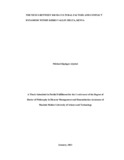| dc.description.abstract | The demographic consequences of conflict and violence in the developing world are
receiving increased attention and so is conflict in Kenya. The Northern part of Kenya in
particular inhabited by pastoral communities such as the Turkana, Pokot, Marakwet, and
Samburu in the Kerio valley Delta, have had years of unresolved conflict. In as much as
cattle raids practiced by these communities are considered a culture, emerging sociocultural
factors have increased conflict dynamism in the Kerio Valley Delta Kenya and
thus the need for conflict management that resonate with new socialization in unending
violence. This study aimed at understanding the relationship between socio-cultural
factors and conflict dynamism. The general objective of this study is to investigate the
nexus between socio-cultural factors and conflict dynamism in Kerio valley delta while
the specific objectives were; To assess the relationship between maintaining status as a
socio-cultural element and conflict dynamism within Kerio Valley Delta; To examine
influence of ethnic identity as a socio-cultural attribute to conflict dynamism within
Kerio valley Delta; To analyse the influence of cultural beliefs system as a socio-cultural
attribute on conflict dynamism within Kerio Valley Delta and To evaluate the
effectiveness of livelihood options as a deterrence of conflict within Kerio Valley Delta.
This study was guided by conflict transformational theory and culture theory. The study
was conducted in Kerio Valley Delta which links Turkana, West Pokot, Elgeyo
Marakwet and Baringo Counties. Through cross cultural and correlation research designs
were used and data collected by use of purposive, simple random, snowballing and
census methods. The study population of this research comprised of community elders;
morans households in six counties-192,575; government officers461-. The total study
population was 193,060. Questionnaires and interviews were used with 196 community
elders, 179 community morans; interviews were used with 54 government officers while
FGDs were used with 125 government officers. Total sample size was 384. The study
adopted a cross-cultural research design and correlational study research design. The
quantitative data received from the questionnaires categorized per objective was
analysed using descriptive and inferential statistical tools while qualitative data was
analysed using thematic/narrative analysis. Computer software was used for coding and
further analysis. The study results show that; maintaining status, ethnic identity, cultural
belief system and livelihood options have a strong and positive relationship with conflict
dynamism in the Kerio Valley Delta. The study thus recommends that conflict
management strategies should focus on current socio-cultural factors. Sustainable
livelihood options such as sedentary pastoralism should be structured with full
government support with aim of developing an otherwise marginalised region | en_US |

